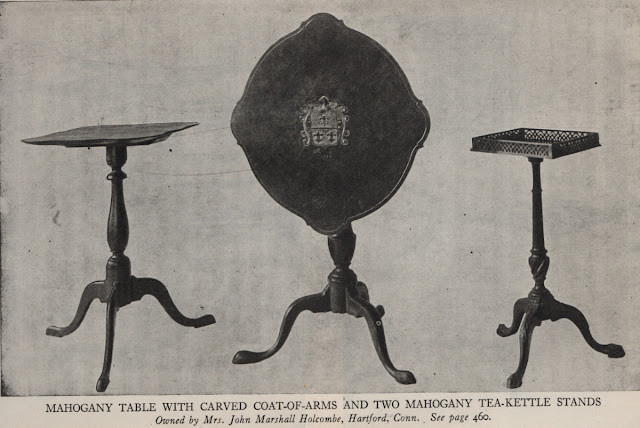Continued from Part Two...To Mr. Smith, whose unlovely productions were being bought by the Prince Regent, the noblity and gentry, it would have been a great surprise to learn that "Chippendale" styles, which he deemed buried beyond resurrection, would be equally pleasing a century after his own were deservedly forgotten. It is remarkable that Chippendale might never have existed so far as Mr. Smith's generation was concerned. Eighteen years later, he find the he himself has become antiquated, but takes comfort from the face that perfection has at last been attained! Describing with some accuracy the sequence of styles in English furniture since the close of the carved-oak period, he says: "At this period (Louis XIV.) the whole system seems to have given place to a style completely Arabesque, although blended with much grandeur peculiar to this taste, and brought to great perfection by the artists then employed in its manufacture. The importation of it into England changed the whole feature of design as it related to household furniture. This taste continued almost unchanged through the reign of George II. and the earlier part of George III. The elder Mr. Chippendale was, I believe, the first author who favoured the public with a work consisting of designs drawn from this school, with great merit to himself, however defective the taste of the choice might be. To this work succeeded that of Mr. Ince in the same style. From this period to the time of Messrs. R. and J. Adam, the same species of design continued, with little or no alteration, until the researches of these scientific gentlemen in architecture and ornament were made public. A complete revolution in the taste of design immediately followed: the heavy panelled wall, the deeply coffered ceiling, although they offered an imposing and grand effect, gave way to the introduction of a light Arabesque style and an ornament highly beautiful. But the period for the introduction of not only a chaste style in the architecture, but likewise of ornament (and which extended to our domestic moveables) was reserved for the late Mr. James Wyatt, whose classic designs will carry his name to posterity with unimpaired approbation. Here it would appear almost unnecessary for invention to have gone farther, but perfection, it appears, was reserved for this present period."

Apart from this book, which brought him into temporary prominence, Chippendale seems to have been an obscurely prosperous tradesman who catered to the tastes of the day. His biographer in the exhaustive Dictionary of National Biography can find little more to say of him than that he flourished circa 1760. He was not the only successful member of his craft in London during the first half of the eighteenth century, if we may believe the following advertisement in a New York paper in 1771:
"To-morrow will be sold at public vendue at the Merchants' Coffee house at twelve o'clock by John Applegate, a very neat set of carved mahogany chairs, one carved and gilt sideboard table, and a Chinese hanging bookcase with several other things. N.B. The back of the chairs is done after the pattern of some of the Queen's; a sketch of which chair will be shown at the time of the sale. The Chairs and other things were made by a person in the Jersies who served his time and afterwards was eleven years foreman to the great and imminent cabinet-maker William Hallet, Esq.; that bought the fine estate of the Duke of Shandos, called Cannon's, in Middlesex; was afterwards a master for about twenty years in London and hath been two years in the Jersies. He will receive any orders for furniture, viz.; Plate cases or best Chinese hanging book-cases or on frames; French elbow chairs, ribbon back, Gothic or any sort of chairs, likewise carved, glass frames, gerrandoles, bracket branches, etc."


